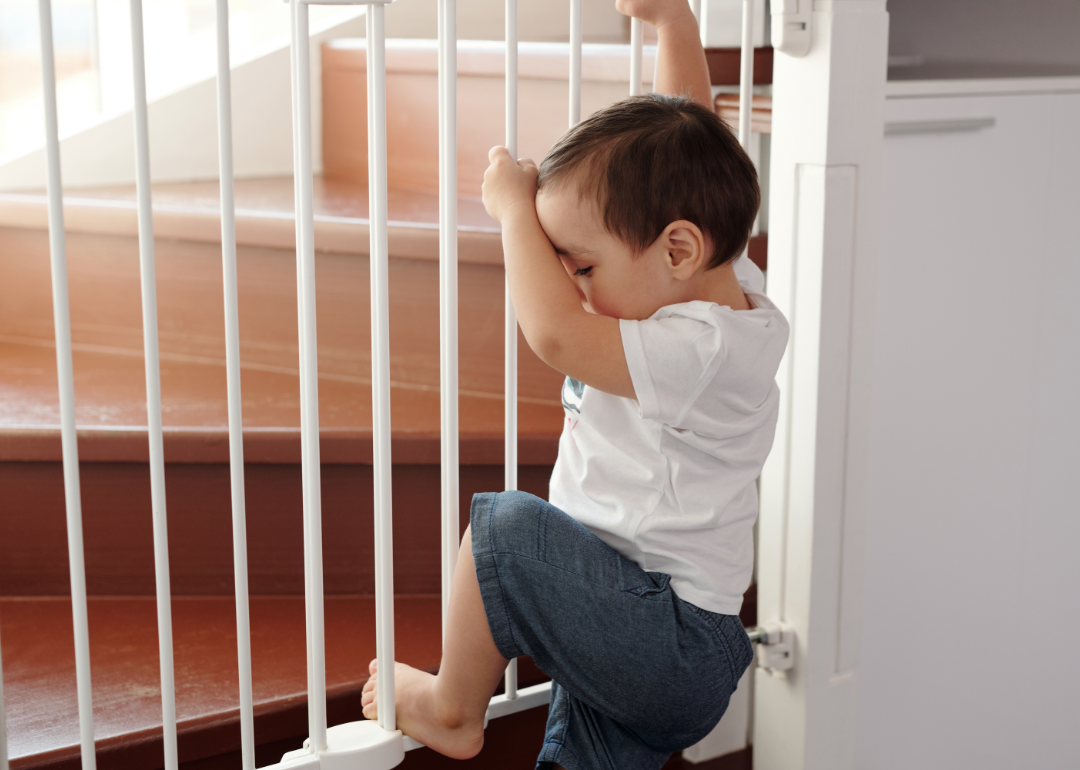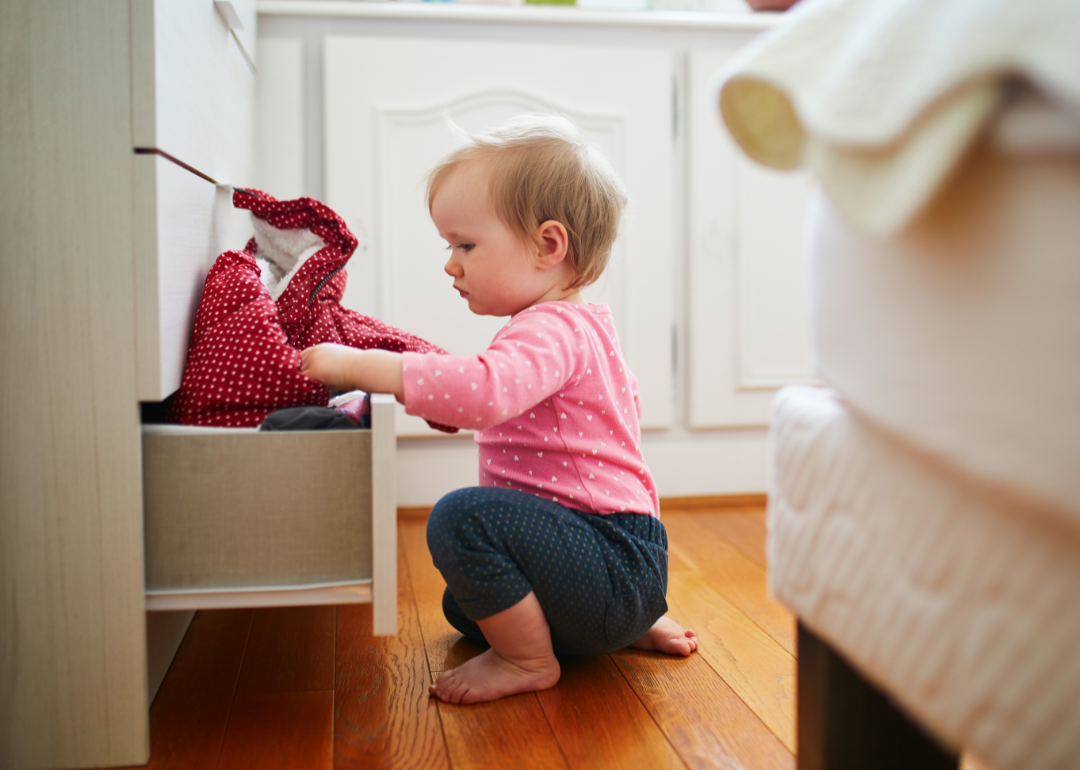5 steps for babyproofing your home: A checklist for every room

Canva
5 steps for babyproofing your home: A checklist for every room
Grinning baby standing behind baby fence.
Welcoming a baby into your home can be exciting and joyful, but it also comes with a huge responsibility. We know you’ve got a million things on your mind before the big day comes, but taking the right measures to babyproof your home should be a top priority.
According to the CDC, unintentional injuries led to the death of more than 7,000 children and teens aged 0-19 in 2019. But 40% of parents agree that proper home safety precautions could have prevented a child’s injury. Today’s Homeowner has compiled the best methods for babyproofing and different child safety products to help make your home safer for your children.
Why babyproof your home?
As babies grow and develop, they become highly curious. They’re eager to explore new places within the home, touch everything, and even put objects into their mouths. This curiosity can lead to dangerous situations.
Hazards like sharp objects or unstable furniture can pose real risks to your child. Babyproofing your home allows your child to explore and grow without significant risk of injury.
When to start babyproofing your home
It’s important to babyproof your home early, ideally before your baby is old enough to crawl. You’ll be ahead of the game by preparing before your due date and continuing after your baby comes home.
If you babyproof your home before the baby arrives, you’ll have time to find potential home hazards and purchase the necessary items to address these issues. Being prepared helps create a safer space for your baby, giving you peace of mind as they start exploring their surroundings.
![]()

Canva
5 steps to babyproof your home
Baby holding onto baby fence rails.
As a new parent, ensuring your home is safe and secure for your little one is likely a top priority. Babyproofing your home can seem daunting, but with a few simple tips, you can create a safe environment for your baby to explore and grow in. Here are five essential tips to help you babyproof your home effectively:
- Take on bigger projects first
- Get on their level
- Prioritize furniture safety
- Inspect for burn hazards
- Utilize Baby Gates
1. Take on bigger projects first
It’s best to tackle the bigger projects before your baby arrives. Start by assessing your home’s overall safety.
If it was built before 1978, check that the paint doesn’t contain lead, as it can pose a huge risk to your baby’s health. Children, especially those under two years old, are extremely sensitive to lead. In fact, children exposed to lead may develop damage to the brain and nervous system, learning disorders, and behavioral problems. If tests show lead paint inside or outside your home, then you should contact a certified lead abatement contractor to completely remove lead paint hazards.
It’s also important to install smoke and carbon monoxide detectors throughout your home to alert you in emergencies.
2. Get on their level
Seeing your home from your baby’s perspective will allow you to spot and address hazards that might have gone unnoticed from an adult’s viewpoint. Get down on the floor to look for small items that could be choking hazards, such as coins, toys, and other household objects. Also, check for small batteries lying around, as they can be extremely dangerous if swallowed.
3. Prioritize furniture safety
Furniture tipping is a significant danger for children, with an estimated 7,900 annual emergency-department-treated injuries of those under 18.
Use furniture and appliance anchors to secure heavy items and prevent them from tipping. Check for sharp corners on tables and other furniture, and consider using corner guards to protect your baby from injuries. Opt for cordless window coverings to prevent strangulation and ensure a safer environment.
4. Inspect for burn hazards
Use screens or barriers to prevent your child from touching heat sources like fireplaces, radiators, or stoves. Set your water heater temperature to 120 degrees Fahrenheit or lower to reduce the risk of scalding. Unplug appliances when not in use, as babies can become interested in turning knobs or pushing buttons, which can lead to potential burns if the appliances are still hot.
5. Utilize baby gates
Installing safety gates at the top and bottom of stairs is crucial to prevent falls and injuries. Use a wall-mounted gate at the top of the stairs for extra security, as pressure gates may not be strong enough to withstand a baby’s force. Use baby gates to block off high-risk areas like the kitchen, bathroom, or laundry room, giving you complete control over where your baby can and can’t go.
Shop for baby gates certified by the Juvenile Products Manufacturers Association (JPMA) — this organization ensures the manufacturer follows specific safety standards during production.

Canva
4 rooms to prioritize when babyproofing
Baby rummaging through bottom drawer.
You should check every room in your home for potential hazards, but some rooms should be considered a higher priority. Let’s explore how to properly babyproof the nursery, kitchen, bathroom, and living room.
Nursery
The nursery is your baby’s sanctuary, so making it safe is essential. Consider making some of the following improvements:
- Using crib sheet holders to keep sheets in place and prevent suffocation.
- Storing baby wipes and other products out of reach.
- Using plush carpets or rugs to cushion falls.
- Positioning the crib away from decorations, lamps, and windows.
- Using toy boxes and baskets that have no top or lip to prevent entrapment, or install a babyproof lock on the lid.
- Installing finger-pinch guards on door hinges.
Kitchen
Most parents agree the kitchen is the most hazardous room in the house, especially for curious little ones. To keep your child safe, consider:
- Storing sharp objects out of reach or in locked drawers.
- Adding burner knob covers to prevent them from being turned on.
- Using non-skid pads under rugs to minimize slips and falls.
- Ensure hazardous items, like cleaning supplies, are stored in locked cabinets.
Bathroom
The majority of parents believe that, second to the kitchen, the bathroom poses the biggest risk of danger to children. Some bathroom safety tips include:
- Installing safety latches and locks on cabinets and toilets.
- Using a bath water thermometer to ensure a safe water temperature.
- Installing anti-scald devices on faucets and showerheads to prevent burns.
- Store cleaning supplies, medicines, and other potentially harmful products out of reach.
- Install magnetic safety locks to keep your child away from bathroom essentials.
Living room
Your living room is a space for relaxation and family time but can also hold hidden dangers. Babyproofing your living room may involve:
- Using door knob covers and door locks to restrict access to certain areas.
- Adding corner and edge bumpers to furniture, shelving and other sharp corners to prevent injuries.
- Putting covers on electrical outlets.
- Tidying up cords and unplugging any devices that aren’t being used to lower the chance of accidents.
By prioritizing these four rooms and following the babyproofing tips provided, you’ll create a safer environment for your baby to grow and explore.

Canva
Smart home devices to keep your baby safe
Baby monitor sitting on ledge of baby crib.
In today’s tech-savvy world, smart home devices can play a significant role in enhancing the safety of your home. The following devices can provide extra protection and peace of mind for parents:
Security cameras
Security cameras are a popular option for monitoring the inside and outside of your home. They allow you to watch your baby when they’re in their nursery or playing in another room. Some security cameras even come with two-way audio features, so you can soothe your baby from afar or communicate with other family members in the house.
Smart locks
Smart locks provide additional security by relieving the stress of remembering to lock the door. They help prevent curious children from venturing outside unsupervised and ensure no unwanted visitors can enter your home. By utilizing smart locks, parents can effectively prevent children from accessing areas like the pool unsupervised, significantly reducing the risk of drowning incidents.
Door sensors
Door sensors are another valuable addition to your babyproofing efforts. These devices can notify you if your child is entering a room they shouldn’t be in — such as a kitchen or bathroom — where hazards may exist. This way, you can respond quickly and prevent potential accidents.
Movement-tracking baby monitors
Movement-tracking baby monitors and baby cameras track your baby’s movements and notify you if there’s any unusual activity or if your baby stops moving for an extended period. This feature can be particularly helpful during nighttime or naptime when you might not constantly watch your baby.
Smart home devices offer a variety of benefits when it comes to keeping your baby safe. They not only provide added security but also give parents the ability to monitor their child’s well-being and prevent accidents more effectively. Investing in these devices can help you create a safer environment for your baby and ensure peace of mind.
This story was produced by Today’s Homeowner and reviewed and distributed by Stacker Media.





